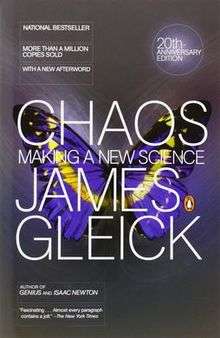Chaos: Making a New Science
 20th-anniversary edition | |
| Author | James Gleick |
|---|---|
| Country | United States |
| Language | English |
| Genre | Popular science |
| Publisher | Viking Books |
Publication date | October 29, 1987 |
| Media type | Print, e-book |
| Pages | 400 pp. |
| ISBN | 0-7493-8606-1 |
| OCLC | 59649776 |
| LC Class | Q172.5.C45 G54 1987 |
| Followed by | Nature's Chaos |
Chaos: Making a New Science is a debut non-fiction book by James Gleick that initially introduced the principles and early development of the chaos theory to the public.[1] It was a finalist for the National Book Award[2] and the Pulitzer Prize[3] in 1987, and was shortlisted for the Science Book Prize in 1989.[4] The book was published on October 29, 1987 by Viking Books.
Overview
The first popular book about chaos theory, it describes the Mandelbrot set, Julia sets, and Lorenz attractors without using complicated mathematics. It portrays the efforts of dozens of scientists whose separate work contributed to the developing field. The text remains in print and is widely used as an introduction to the topic for the mathematical laymen. An enhanced ebook edition was released by Open Road Media in 2011, adding embedded video and hyperlinked notes.[5]
Reception
Robert Sapolsky said that, along with Baby Beluga, Chaos has had the greatest influence on his life.[6]
References
- ↑ "Chaos Theory: A Brief Introduction". Archived from the original on August 5, 2013.
- ↑ Gleick, James. "National Book Awards - 1987". Chaos: Making a New Science. National Book Foundation. Retrieved 28 May 2011.
- ↑ Gleick, James. "1988 Finalists". Chaos:Making a new Science. The Pulitzer Prizes. Retrieved 28 May 2011.
- ↑ Gleick, James. "Royal Society Prize for Science Books. Shortlisted Entries". Chaos. The Royal Society. Retrieved 3 June 2011.
- ↑ Maynard, Andrew. "James Gleick's Chaos – the enhanced edition". Review. 2020 Science. Retrieved 18 August 2011.
- ↑ https://www.youtube.com/watch?v=NNnIGh9g6fA&t=47m20s